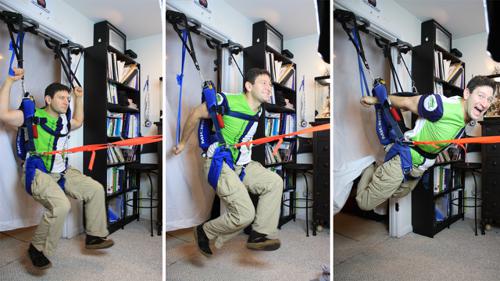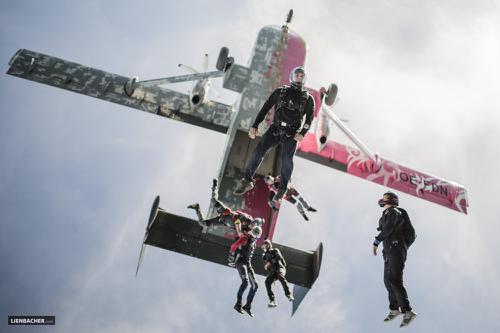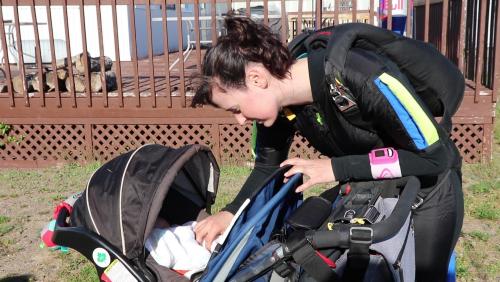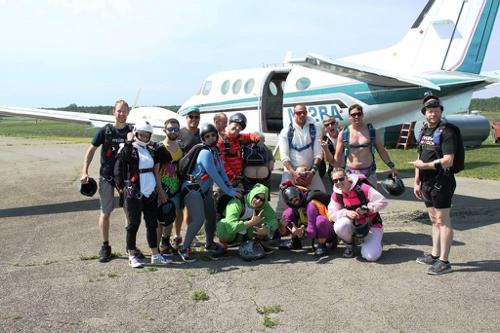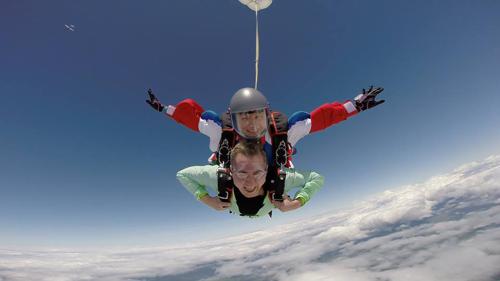Tandem Skydiving
What Is Tandem Skydiving?
Tandem skydiving is an extremely popular form of skydiving and an excellent introduction into the sport, it allows one to experience the adrenaline and excitement without having to commit excessively to the activity at hand. While AFF training and static-line jumping consists of hours of training prior to the jump, going tandem only requires around 30 minutes of ground preparation prior. The reason for this is that while both AFF and static-line skydives require you to learn how to control your canopy and establish a deep knowledge of maintaining specific body positions in free fall, with tandem skydiving you only need to know the basics about how you should position your body relative to your tandem master. The fact that your tandem instructor will be responsible for your chute leaves you with the ability to spend more of your effort focusing on the sheer excitement of the jump, as opposed to what procedure who'll be doing next.
You, the tandem student, will be strapped to a tandem instructor by use of a secure harness system which makes use of a shoulder strap on either side, a chest strap which secures across your chest, as well as leg straps. You will be strapped onto the chest, or front side of the tandem master, so you can be sure that you'll have the best view in the house.
While tandem jumps are most common as once off introductions to skydiving, they are also sometimes used in conjunction with training courses, specifically in the early stages of a course. Using tandem jumping in training methods when you want to learn how to skydive can be extremely effective as it allows the student to experience both freefall and canopy flight without the feeling of being thrown into the deep end, so to speak. There are also students who look to perform several tandem skydives prior to their training course in order to familiarize themselves with the environment.
A tandem freefall generally lasts between 45 and 60 seconds, followed by a four minute canopy ride to the ground.
Where To Start?
For starters, you want to make sure that you are going to be skydiving at a drop zone that has a good reputation. There are over a thousand drop zones around the world and each offer a different experience, some good and some poor. Dropzone.com has been developed around helping you to find the best drop zone in the area of your choice, and providing you with user ratings and reviews to help you make your decision. Look for drop zones with large volumes of positive reviews, and take the time to read through them and see what issues other users may have experienced at any particular drop zone. Unlike static-line progression for example, tandem skydiving is done at almost every drop zone, so you should be fine in that area, but be sure to check and make sure.
When comparing drop zones it's vital to make sure you that you understand what you will be receiving with your jump. A tandem skydive can take place between altitudes of anywhere from 10 000 to 14 000ft, if free fall time is of importance to you it's certainly worth querying this topic with the drop zone. Another important question is, if you're paying a lot for your jump, are they offering you the best services for the amount you're paying? Does your jump include video footage or still photography, most have this as an extra cost - so be sure to check what the drop zone is charging for their video services. And if it does offer video services, is this filmed from a mounted camera attached to the tandem instructor or are they pulling out all the stops and having a separate photographer joining the jump solely to take some quality photographs of your jump. These are all aspects which should be examined and considered when you're scouting for the best drop zone in your area.
Once you've located a drop zone near to your destination, give them a call or send them an e-mail, they should be more than willing to address any questions you may have about your jump and guide you through the booking process, setting you up with a date to jump.
Some Advice To Consider Before Making Your Tandem Jump
While you're likely to be walked through the correct dos and don'ts during your pre-jump ground briefing, it doesn't hurt to prepare prior to the day for what you should be doing and what you shouldn't be doing for your jump.
Remove jewelry and accessories prior to Tandem Skydiving. At 120mph, it begins very easy for loose jewelry or accessories to come loose during free fall and get lost. It's a good idea to leave the jewelry at home on the day of your jump.
Remove piercings, specifically nipple rings. When the canopy is opened during flight, your chest strap will pull against you, and there have been cases where people have had nipple rings pulled when this occurs - learn from their mistakes. Remember that there are also harness straps around your legs, so be sure to remove all piercings that may be impacted. Removing all piercings leave less gambling for something getting snagged, but nipple and surface piercings are definitely best removed.
Tie up your hair. Whether you're male or female, if you have long hair it is a wise idea to tie it up in a manner that makes it least likely to get caught in the harness at any stage - and also remain out of the TIs face. Tucking it into the helmet once tied is also not a bad idea.
Stick close to your tandem instructor. Once you're leaving the manifest for your jump, be sure to remain close to your tandem instructor.
Always listen to your tandem instructor. They are the ones that know best, despite what you think you know - as an inexperienced tandem skydiver, your tandem instructor should not be questioned when it comes to anything related to the procedure of, or the jump itself.
Be respectful and polite. While you may be frustrated at things like weather holds, it's important to remain calm and realize that these events are often out of the control of the instructors and the manifest staff.
Image by Lukasz Szymanski
Tandem Instructors
The tandem instructors or tandem masters are going to be the ones in control of your skydive. The fact that the tandem instructor has control over the safety of the jump has prompted strict rules and regulations, especially within the United States, as to who can lead a tandem jump. The current requirements set in place go a long way in providing peace of mind that you're going to be in excellent hands when in the air. Before a skydiver is able to be the tandem instructor on a jump, he has to go through several procedures.
First he has to be an experienced skydiver with a minimum of 500 jumps and 3 years of skydiving experience to his name, secondly he must possess a 'master parachute license' which has to be issued by an FAA-recognized organization, such as the USPA (United States Parachute Association). Furthermore, they are required to undergo training and acquire a certification related to the canopy they are going to be flying. On top of these requirements, the USPA has a few more of their own. Up until late 2008 in the United States, one was able to either be a tandem master with a manufacturer's rating or a tandem instructor which required the USPA training, though this was changed and now requires all those leading tandem jumps in the United States to hold a tandem instructors rating. The details of the ratings systems and the requirements vary between countries.
One thing that separates the best drop zones from a bad drop zone for those doing a tandem jump, is the attitude and behavior of their tandem instructor. Luckily, if you've done your research and found yourself a good drop zone, this shouldn't be a worry and you may well end up making a new friend in the process. A good instructor is one that is able to answer any questions you have, while at the same time making you feel comfortable and relaxed. The best instructors find a perfect balance between safety and professionalism and humor, after all the jump is pointless if you don't enjoy yourself.
Should I Be Nervous About Tandem Skydiving?
It's completely normal to feel nervous about skydiving, even those of us who seek adrenalin constantly have some level of nervousness at times. Jumping out of a perfectly good plane, whether it is while experiencing a tandem jump or even the thrill of wing suiting, is not something natural to us as humans, and you can be sure that you're not alone in what you feel. With that said though, as with many areas where what you're facing is foreign and unknown, your fear often tends to turn to excitement once you're in it. I have seen a countless number of first time tandem skydivers being a bit unsure in the beginning but once their feet touch the ground their mind set changes completely. These are often people performing a bucket list jump with no intention of ever skydiving again, but after they've experience the feeling of free fall, they are hooked - and often end up booking their AFF courses to become a licensed skydiver just a few days later. Tandem skydiving has an excellent safety record for most parts of the world and you can take comfort in the fact that according to the United States Parachute Association, around half a million people each year choose to tandem skydive in the US alone.
How Much Does A Tandem Jump Cost?
The price of tandem skydives vary between drop zones, generally you're looking in the price range of about $120 to in excess of $300. This cost can either include or exclude the cost of things like a camera man and a video copy of your skydive. We highly recommend that you look into the prices and the specifications at each drop zone. For more information read below...
Things To Know About Tandems
There are typically restrictions on age when it comes to performing a tandem jump, the exact age varies depending on country and drop zone. The typical requirement from most drop zones is 18, though some drop zones do allow for 16 to 18 year olds to perform a tandem jump as long as they have parental consent. It is best to speak to your local drop zone about their age policies.
When booking a tandem skydive it's important to know what to expect, often once off tandem jumpers go in without knowing what a skydive entails, how drop zones operate and what to expect.
Understand that skydiving hinges on the weather conditions, when the winds are too strong or it's too cloudy, or if there's fog - you may well find yourself on the end of a weather hold. This is an aspect of skydiving that no one is free from, and the experienced jumpers get just as disappointed when they don't get to head out. Weather holds can last anywhere from 5 minutes to 5 days, depending on the conditions.
Because of this it's best to plan your skydive around your local weather, if you're in an area with lots of summer tropical rainfall - it may be best to book in the autumn or winter months when rainfall is less likely, otherwise booking for an earlier time in the day before daytime heating causes the development of thunder showers.
In areas of winter rainfall, summer is obviously your best bet, though nothing can ever be guaranteed. There are areas where weather holds are rare, and if you're in one of these areas that sees little annual rainfall, you're likely to see your jump happen without any hassles.
It's highly recommended that you discuss deposits and payments with the drop zones prior to booking. While most DZs will gladly discuss openly and honestly with you their rules and restrictions in regards to deposits and refunds, many fail to bring up this topic prior to finalizing their booking and they end up upset when they find out that there is no refund issued for deposits on jumps that are postponed due to weather holds.
How Safe is Tandem Skydiving?
A common question asked by those intrigued by the idea of a tandem jump, is whether or not it is safe. And just how safe it truly is. We've long tracked fatalities in our database and can help in easing some of the anxiety you may have around tandem skydiving safety. The reality is that as with any high risk sport, there is the potential for death, though with that said - tandem skydivers remain the least likely to suffer at the hands of a fatality than other jumpers. Between the years 2005 and 2019 there were less than 100 tandem fatalities, with our records pointing closer to around 60. In that same time frame, our records indicate a total of just more than 700 fatalities, meaning that less than 1 out of 10 skydiving fatalities were tied to tandem skydiving.
The important thing to remember is also that tandem skydives are extremely popular and on average there are an estimated 250,000 tandem jumps performed each year in the United States. So while calling tandem jumps safe may be a bit of a subjective statement, the truth is there are a number of aspects of your daily life that hold more risk than completing a tandem jump.
The Technical Side And Skydiving Gear
There are a few things you should remember when you are looking at the more technical side of your skydiving gear.
Skydiving canopies are designed specifically for certain disciplines of skydiving, for speed and immediate response smaller canopies are used - such as those designed for swooping, these smaller canopies are also more dangerous, allowing for less margin of error. For tandem skydiving, where safety takes priority, the canopies (parachutes) used are much larger than those that you find in swooping for example. This is both because the canopy is going to need to carry twice the regular skydiving weight and because of the desired gentle nature of the canopy flight.
The rig that is used by your tandem instructor is set up so that it will provide optimum safety for you on your jump. The rig contains an AAD (automatic activation device) which is a safety device that is designed to automatically fire the main chute after a skydiver descends past a certain altitude and has not yet fired the main canopy. There is also the special tandem canopy, which will be the parachute that is deployed during freefall, also known as the main. There is also a reserve canopy, this is a backup that exists in case of a failure on the main, an example would be, if a main canopy opens with a line twist and one is not able to recover from it - the main would be cut and the reserve deployed. These are packed into what is known as the container, the backpack looking item on the back of the tandem instructor. The instructor will also be carrying an altimeter on him, usually around the wrist, which can provide visual or audio information on the progression of the descent, so that he can release the main canopy at the correct time.
During free fall, you can expect to reach speeds of up to 120mph (180km/h).
Once you've done your skydive, remember to come back to dropzone.com and let us know what you thought of your experience, by rating the drop zone you jumped at.
Safety and Training Forum
Find a place to jump in your area.

